YouTube’s algorithm in 2025 is primarily driven by user engagement, past viewing behavior, and virality. The majority of traffic on the platform comes from YouTube’s recommendation system, which suggests videos based on what users have previously watched, liked, and engaged with. This means that YouTube prioritizes videos that generate high watch time, engagement (likes, comments, shares), and strong click-through rates (CTR).
A smaller yet significant portion of traffic comes from search, when users actively look for videos using specific keywords. YouTube SEO is effective for certain types of content, particularly in niches where people frequently search for information, tutorials, or reviews.
When optimizing YouTube videos, creators face a crucial choice: go for an organic, SEO-driven strategy or aim for viral success through YouTube’s recommendation system. Trying to master both at once can often backfire, as each approach requires a different mindset and execution.
Organic vs Viral Strategy
Videos optimized for search rely on long-tail keywords in the title, description, and tags to rank higher in search results. This strategy ensures steady traffic over time, as people consistently search for certain topics.
However, there's a trade-off.
SEO-friendly titles tend to be more straightforward and less compelling, which can result in lower click-through rates (CTR).
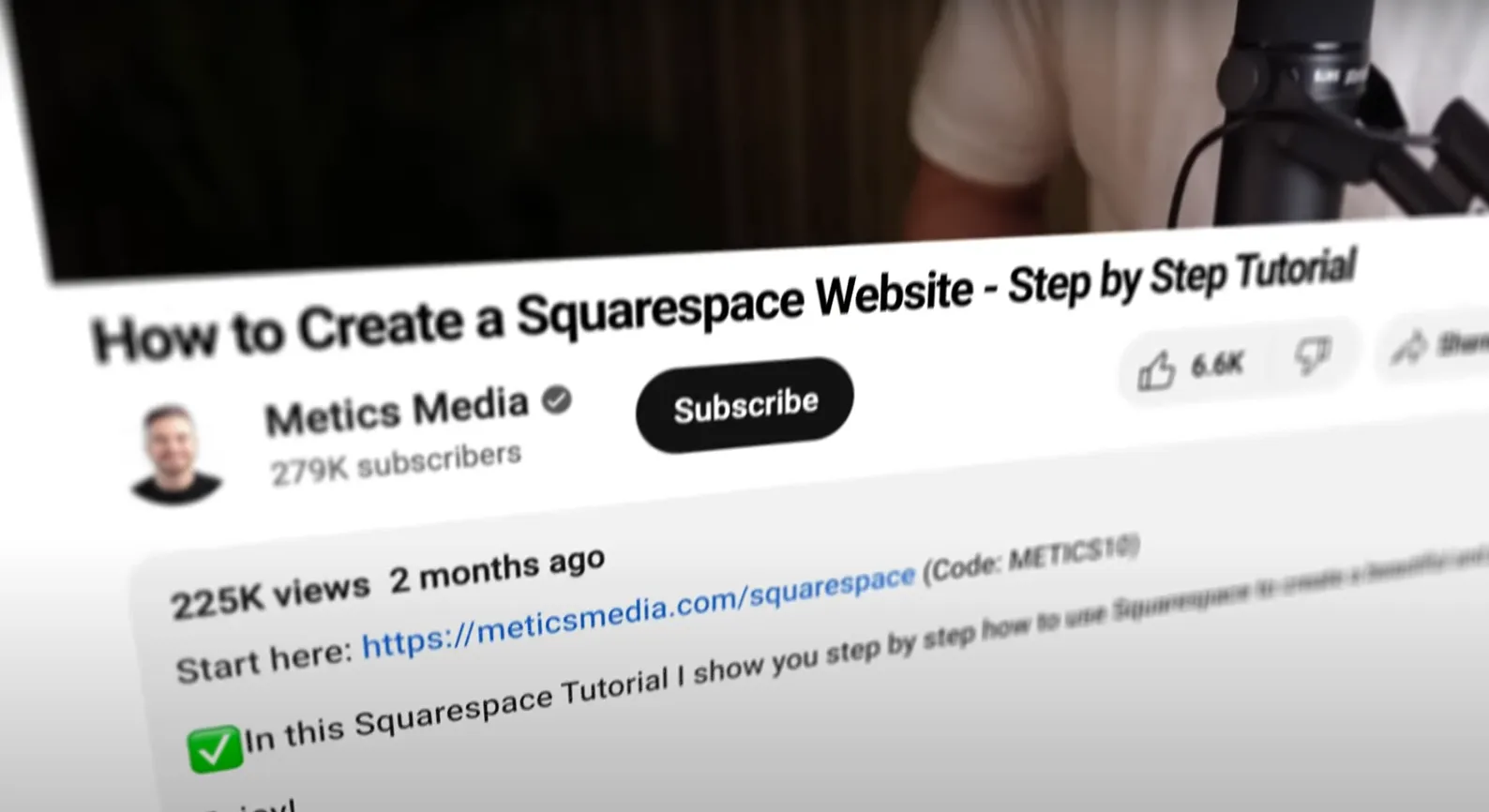
Why? Because highly optimized titles often lack the click-driving elements that make people stop scrolling and click such as curiosity or emotional triggers.
While SEO-driven videos can generate traffic for months or even years, they rarely go viral. YouTube’s algorithm favors videos that people not only search for but also can’t resist clicking on when they appear in suggested feeds.
Viral Videos
On the other end of the spectrum, viral content focuses on grabbing attention and maximizing CTR. This approach is less about keyword placement and more about crafting titles and thumbnails that spark immediate interest.
Viral title example: "I did this to boost sales"
No keywords in the title means bad SEO performance, but since the title sparks curiosity it has a better chance of going viral and getting recommended.
Videos designed to go viral can bring in massive waves of traffic quickly, but they often have a shorter lifespan. If YouTube’s recommendation system stops pushing them, views can decline just as fast as they spiked.
So, which approach is better?
That depends on your long-term strategy.
SEO-driven videos provide reliable, long-term traffic and are great for evergreen topics, while viral-focused videos create explosive growth but often fade unless they continuously gain traction.
In this article we'll focus on search traffic.
YouTube vs Google Traffic
Since Google owns YouTube, it naturally prioritizes video content in its search results. A well-optimized video doesn’t just have the potential to rank on YouTube, it can also secure a top spot in Google’s search results, unlocking an additional stream of organic traffic.
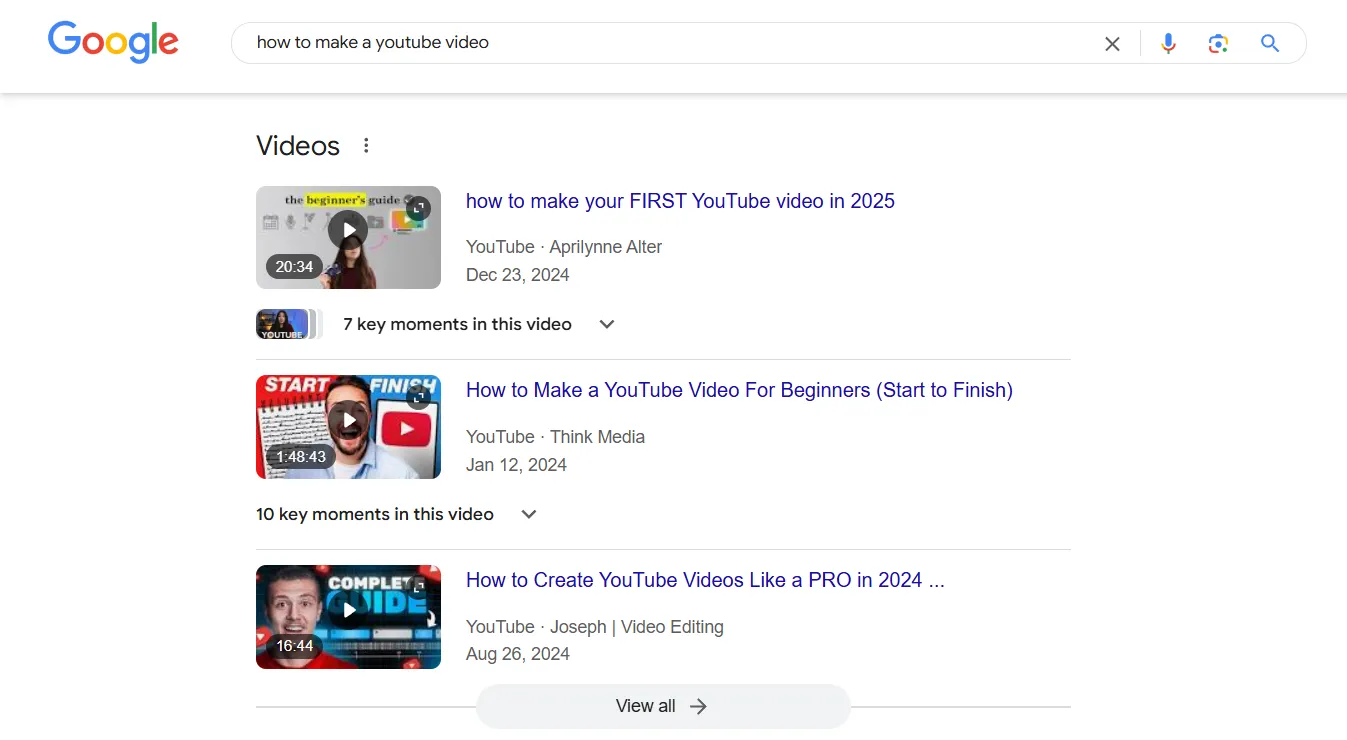
The key is understanding which keywords trigger video results on Google. Not all search queries display videos, but certain topics (especially tutorials, product reviews, and “how-to” searches) often include a carousel of YouTube videos at the top of the results page.
Before committing to a keyword, the first step should be checking if Google shows video results for it. If a keyword has video placements in search, ranking for it means you’re not just competing for views on YouTube, but also gaining exposure on Google. This dual visibility can significantly increase traffic, making it a highly effective strategy for long-term growth.
Keyword Research
Keyword research is the foundation of a successful YouTube SEO strategy. To maximize visibility, you need to find keywords that have search volume and, ideally, trigger video results in Google search. This ensures your video has the potential to rank in two places: YouTube’s internal search and Google’s search results.
Since YouTube doesn’t officially provide exact search volumes for keywords, third-party tools like Ahrefs and Google Keyword Planner become essential. Ahrefs does a good job of estimating YouTube keyword volume, while Google Keyword Planner provides insights into broader search trends.
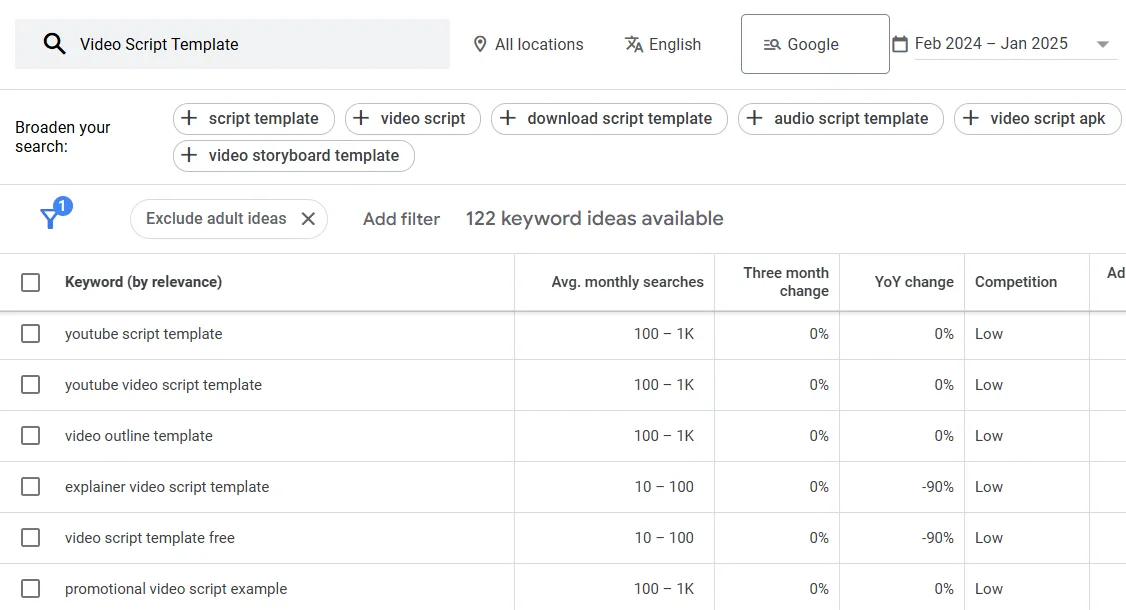
In order to see the exactly monthly search volumes you'll need to setup and run a paid ads campaign, otherwise you'll see search ranges like on the image.
A good rule of thumb: if a keyword has solid search volume on Google, it likely has at least some demand on YouTube as well.
When researching, focus on:
- Main Keywords – These are your primary target keywords, usually short and highly relevant to your video’s topic.
- Long-Tail Secondary Keywords – These are variations or related searches that provide additional ranking opportunities.
For example, let’s say you’re making a video about "Video Script Template". Your keyword research might reveal:
- Main keyword: "video script template"
- Secondary keywords: "how to write a video script," "best video script format," "video script example for YouTube"
Note down and cluster all keywords according to relevance into a notepad or a spreadsheet as we'll use them in video title, description, and tags, while secondary keywords can be sprinkled naturally in your description and captions.
On-Page Video SEO
Title Optimization
Your title is one of the most important elements for ranking on YouTube and Google. It's crucial to include your main keyword as early as possible in the title, ideally at the very beginning. This signals to both YouTube and viewers what the video is about right away. Titles should also be descriptive, providing a clear indication of the value the viewer will get by clicking.
Videos that rank on top positions for high volume keywords have the main keywords early in the title.
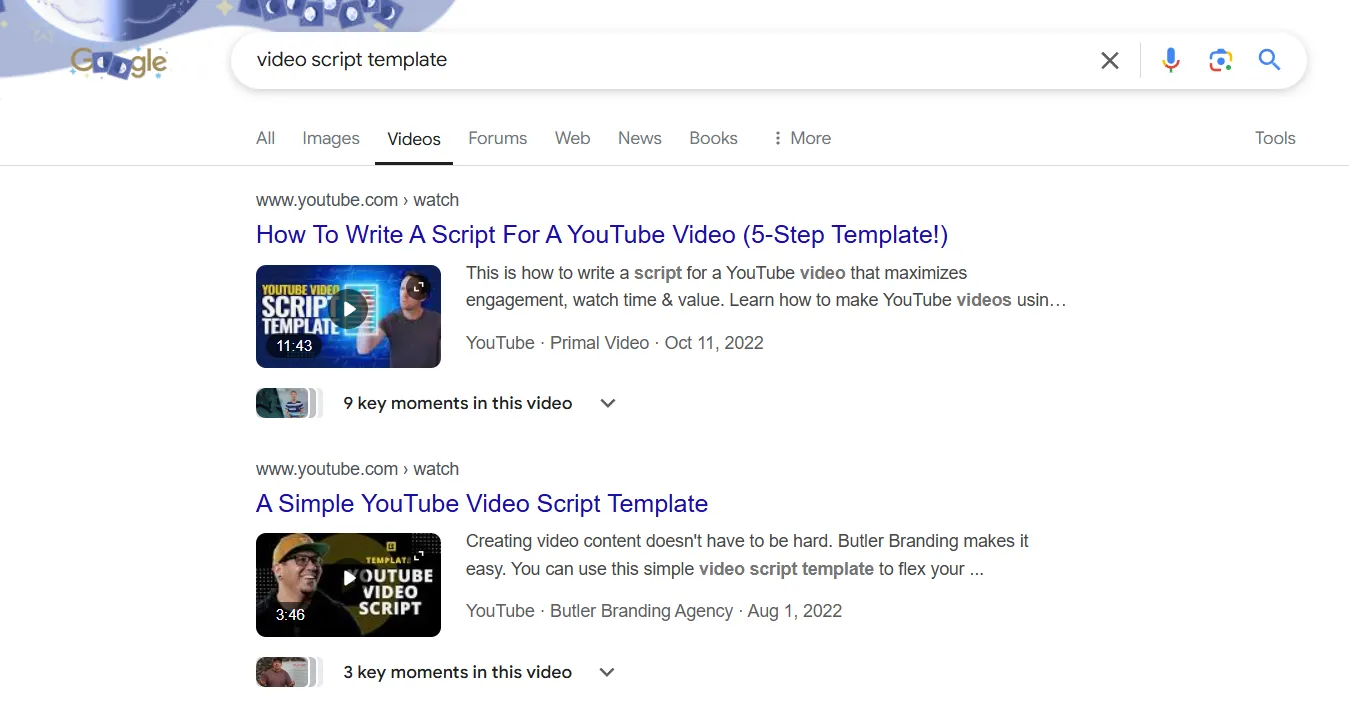
A good example of a well opimized title is this: How To Write A Script For A YouTube Video (5-Step Template!)
It contains the main keyword early on, as well as secondary keywords, and at the end an element that helps with CTR.
In addition to the main keyword, consider including secondary keywords within the title as well. While you don’t want to overstuff the title with keywords, it’s helpful to target longer, multi-word phrases that are highly relevant to your video’s content. A well-crafted title not only helps with SEO but also increases the likelihood of getting clicks from search results and recommendations.
Description Strategy
The video description gives you an excellent opportunity to target additional keywords. Although YouTube doesn’t officially prioritize description length, the more detailed your description, the more chances you have to rank for a variety of keywords. By writing a longer, descriptive text, you allow space to naturally incorporate a wider range of secondary keywords.
Having a lengthy description not only helps you target known keywords, but it also increases the chances of ranking for related search terms you might not have initially considered.
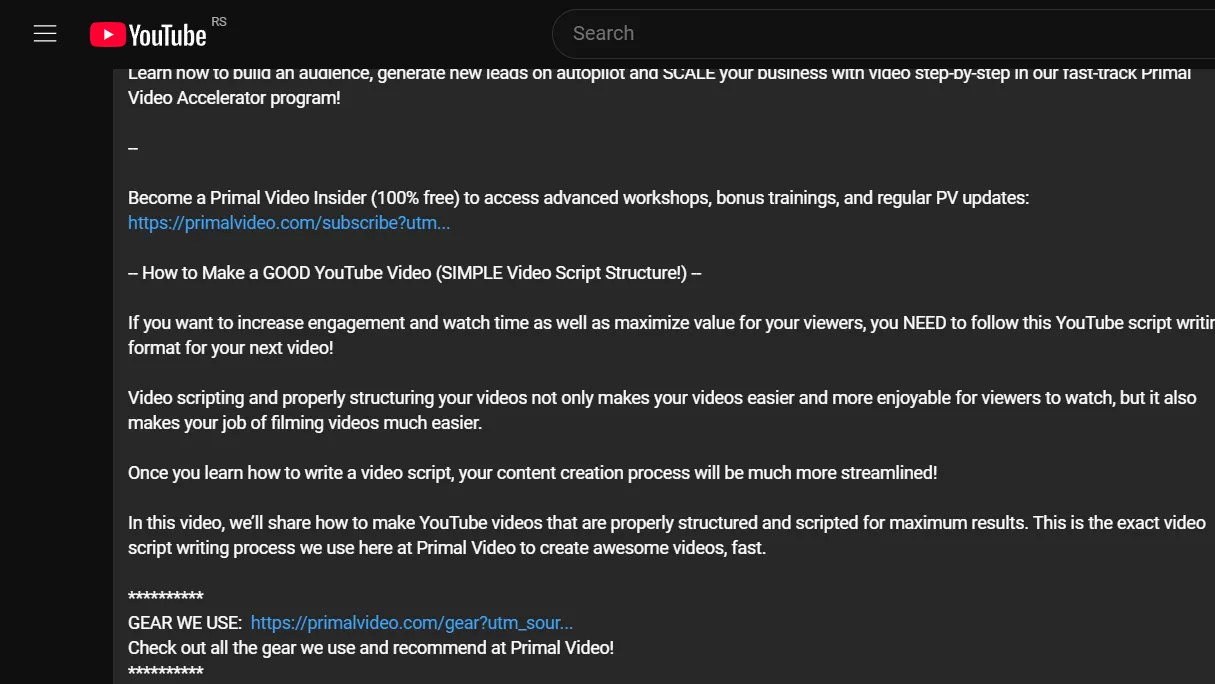
The more relevant text in the description, the more likely it is that YouTube will extract useful data from it and associate your video with additional search queries. Aim to include the main keyword early in the description and then weave secondary keywords in a natural, engaging way throughout the rest of the text.
No need to write essays. Follow this framework:
- Have a call to action at the top
- Describe in a few paragraph the topic
- Add links to affiliate links with text describing each recommendation
- Add a disclaimer
There you go, now you have a lenghtly description in which you can add secondary keywords.
Too lazy to write descriptions? Use ChatGPT!
Mention Keywords Early in the Video
YouTube’s algorithm takes note of the spoken words in your video, as it generates captions. By mentioning key terms early on in the video, you increase the chances of YouTube’s algorithm picking them up and associating them with your content.
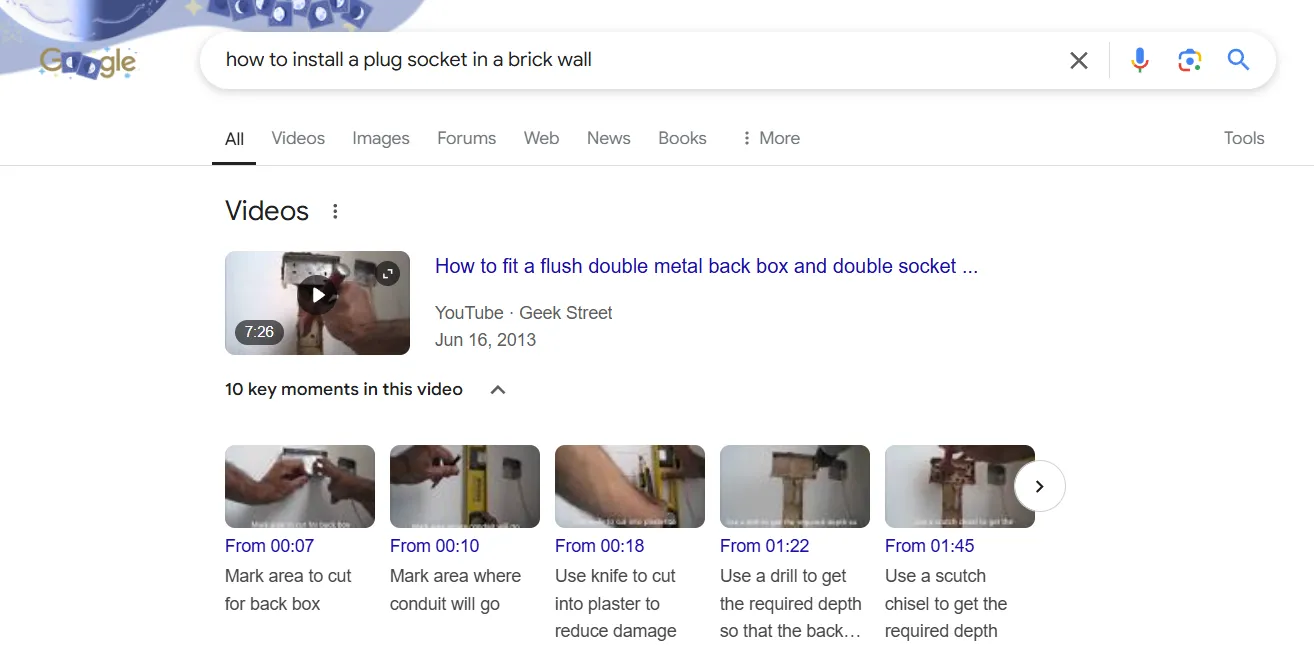
This is crucial for both YouTube search and Google search, as the algorithm timestamp keywords throughout the video. Early mentions of keywords will play a significant role in how your video ranks for related queries.
Since YouTube automatically generates captions, it can extract keywords from them to understand the content of the video. The earlier you mention relevant terms, the more likely they are to be indexed properly and shown as relevant to the topic, giving you a better chance to rank.
Use VidIQ Google Chrome Addon to automatically generate video tags on upload.
Tags
Tags provide another way to signal to YouTube what your video is about. Though they don’t have the same weight as the title and description, tags are still important for helping YouTube categorize your video.

Include your main and secondary keywords as tags, along with a few related terms. For example, if your video is about a video script template, tags might include “video script template,” “YouTube script,” “how to write a video script,” and “video production tips.” This helps YouTube understand your video’s content and show it to the right audience.
Engage with Comments
Ask viewers to comment with relevant keywords to boost both engagement and SEO. When viewers leave keyword-rich comments, it signals to YouTube that your content is engaging and provides additional context for the algorithm to rank your video higher. These comments help reinforce the video’s relevance to search terms, especially if those keywords appear in the comments.
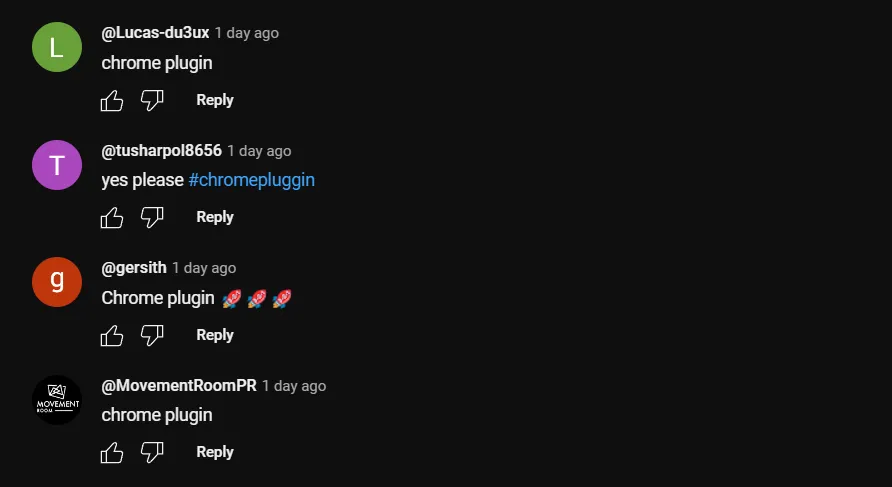
Encouraging keyword-based comments strengthens your overall SEO strategy, helping your video gain visibility on YouTube and Google. It's a simple yet effective way to increase rankings and drive more traffic to your video.
Backlinks
Backlinks are links from other websites pointing to your content. They are one of the most important ranking factors for Google, as they signal to the search engine that other sites vouch for your content's relevance and authority.
Backlinks are essential for ranking websites, not just YouTube videos, on Google. For YouTube videos, backlinks primarily influence your ranking in Google’s search results, not YouTube search itself.
This is where a concept called parasite SEO comes into play, which refers to ranking content that isn’t hosted on your own website (such as YouTube videos) by leveraging the authority of a platform like YouTube.
If there’s no video spot available on Google for a particular search term, then no matter how many backlinks you build, the video won’t show up on Google.
Backlink Profile and Analysis
When analyzing how well your video is performing in terms of backlinks, you might be surprised by what you find. For videos that rank high on Google, backlinks aren’t always the main factor. In fact, many of the top-performing YouTube videos in Google search results tend to have surprisingly few backlinks. This suggests that YouTube's domain authority is so strong that videos can often rank organically without needing a ton of backlinks.

But that doesn't mean backlinks are irrelevant. By using the free version of Ahrefs, you can still uncover the few key backlinks that are helping your competitors rank. The free tool allows you to analyze competing videos to see which backlinks they have, giving you the opportunity to replicate their strategy and build similar links to give your video a ranking boost.
This means you don’t need the premium version of Ahrefs to get started, just use the free tool to analyze which backlinks might be giving the top-ranking videos an edge, then go ahead and build similar, high-quality links for your own video. This insight can help you make smarter decisions when optimizing your video for Google search.
Using Backlinks for YouTube SEO on Google
If you’ve found a keyword with a video spot on Google search results, then you should absolutely focus on building backlinks to that video. But not all backlinks are created equal. To maximize the impact on your YouTube video’s ranking on Google, you’ll want to focus on two types of backlinks: embed links and contextual links.
Embed Links
Placing your video on high-authority websites through embedded content is a powerful way to get quality backlinks. This could be through guest posts, relevant blog posts, or other authoritative platforms in your niche. An embedded video link can generate significant traffic, and it also passes valuable SEO juice back to your video, helping it rank higher in search results.
Contextual Links
These are links placed within content on relevant, high-DR (Domain Rating) websites. Contextual backlinks are considered one of the most valuable types of backlinks because they are naturally integrated into relevant content, increasing their weight in Google's eyes. For YouTube SEO, these backlinks help signal that your video is relevant and authoritative for the keyword you're targeting, pushing it higher in search rankings.
By building a strong backlink profile with these high-quality links, you can significantly improve your chances of ranking YouTube videos on Google. However, remember that this strategy only works when there’s a video spot available on Google search results, if not, even the best backlinks won’t help.